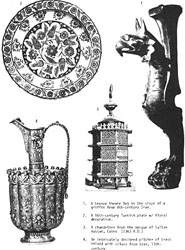|
of the microscope and the telescope. Al-Haytham did not limit himself to one branch of the sciences, but, like many of the Arab scientists and thinkers, explored and made contributions in the fields of physics, anatomy, and mathematics. In Europe, he was known as Alhazen.44 The Crafts Because the Arabs believed that the arts served the Faith, they raised small scale artistries to new levels of perfection. Glass making, ceramics, and textile weaving attested to their imagination and special skills. They covered walls and objects with intricately detailed mosaics, tile, carving and painting. Syrian beakers and rock crystal were highly sought after in Renaissance Europe, and the Azulejos, the irredescent lustre pottery from the Moorish kilns in Valencia also enjoyed great popularity. New glazing techniques were developed, and the brilliant blues took on many names. The Chinese called them Muhammedan blues, Dutch traders called them Chinese blue45 -- an interesting reflection of the cultural exchanges between countries and their artisans. They were masters of silk weaving and the Arab cape worn by Sicily's King Robert II on his coronation is one of the examples of this delicate art.46 Cotton muslin. Damask linen and Shiraz wool became watchwords of quality in textiles in Europe. Today, we speak of Morocco leather as of especially fine quality. The Moroccan tanners of the Middle Ages developed methods for tanning hides almost to the softness of silk and used vegetable dyes that retained color
|
